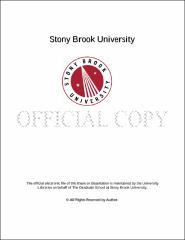| dc.identifier.uri | http://hdl.handle.net/1951/60218 | |
| dc.identifier.uri | http://hdl.handle.net/11401/71486 | |
| dc.description.sponsorship | This work is sponsored by the Stony Brook University Graduate School in compliance with the requirements for completion of degree. | en_US |
| dc.format | Monograph | |
| dc.format.medium | Electronic Resource | en_US |
| dc.language.iso | en_US | |
| dc.publisher | The Graduate School, Stony Brook University: Stony Brook, NY. | |
| dc.type | Dissertation | |
| dcterms.abstract | The eukaryotic and prokaryotic planktonic microbial communities in Great South Bay (GSB), NY, were characterized using Terminal Restriction Fragment Length Polymorphism (TRFLP) for both 18S rDNA and 16S rDNA in 2008 when there was an Aureococcus anophagefferens &lsquobrown tide&rsquo bloom and in 2009 when there was no bloom. TRFLP data and A. anophagefferens cell counts using microscopy demonstrated both a spring and a fall bloom in 2008. Non-metric Multidimensional Scaling analysis of TRFLP profiles from samples collected along a ten station transect in the middle GSB from May to October (2008) and May to December (2009) revealed that while plankton community structure could change dramatically from week to week, in the same week both 18S and 16S community structure were relatively uniform across the entire transect. Nevertheless, differences in the 18S community between stations generally increased as the geographical distance between two samples increased. The 16S community showed less spatial heterogeneity. Ordination analysis of the two year data set suggested that A. anophagefferens was important in shaping the community structure. During 2008, the diversity of the 18S community measured with four biodiversity indices was significantly lower for samples collected during brown tides than samples collected from non-bloom conditions, while there was no significant difference for the 16S community. In general, the 18S community was more diverse in 2009 than in 2008 while the opposite was the case for the 16S community. According to the picoalgal niche hypothesis of Sieracki and colleagues, the phytoplankton niche is open to picoalgae in Long Island waters in early summer. The hypothesis states that Synechococcus usually dominates the picoalgal niche, but at times when the net growth rate of Synechococcus declines, similarly sized picophytoplankter A. anophagefferens becomes dominant. A reciprocal temporal pattern of the relative abundance of Synechococcus and A. anophagefferens was indeed observed in this study. Additionally, local similarity analysis revealed negative associations between A. anophagefferens and four picophytoplankton: Synechococcus, Bathycoccus, Picochlorum and Picocystis. The picoalgal niche is, therefore, proposed to be expanded to include all the above picoalgae, among which Bathycoccus was unique because it was the only species negatively associated with all other picophytoplankton in the non-brown tide year. In late July the picoalgal niche was taken over by Synechococcus and pico-chlorophytes, probably due to water temperature becoming too high for A. anophagefferens. Therefore, the earlier timing of A. anophagefferens' increase (spring) than Synechococcus (summer) in 2008 and the higher relative abundance of Bathycoccus in 2009 than 2008 especially in spring implies that Bathycoccus, instead of Synechococcus, may compete with A. anophagefferens for the picoalgal niche in springs of Long Island waters. Both water temperature and selective grazing of zooplankton on other picophytoplankton may have favored A. anophagefferens forming a fall bloom. One piece of evidence that A. anophagefferens might be under less grazing pressure than other phytoplankton is from local similarity analysis, where A. anophagefferens was negatively associated with only one group of grazers while other phytoplankton always had multiple significant associations with grazers and parasitoids such as Telonema, Amoebophrya and Pirsonia, which have not been reported for GSB previously. Turbulent conditions caused by wind mixing may have also helped A. anophagefferens outcompete other phytoplankton in 2008. | |
| dcterms.available | 2013-05-24T16:38:14Z | |
| dcterms.available | 2015-04-24T14:47:44Z | |
| dcterms.contributor | Collier, Jackie L, Aller, Josephine Y | en_US |
| dcterms.contributor | Kemp, Paul F | en_US |
| dcterms.contributor | Cerrato, Robert M | en_US |
| dcterms.contributor | Taylor, Gordon T | en_US |
| dcterms.contributor | Delong, Edward F | en_US |
| dcterms.creator | Liu, Yuan | |
| dcterms.dateAccepted | 2013-05-24T16:38:14Z | |
| dcterms.dateAccepted | 2015-04-24T14:47:44Z | |
| dcterms.dateSubmitted | 2013-05-24T16:38:14Z | |
| dcterms.dateSubmitted | 2015-04-24T14:47:44Z | |
| dcterms.description | Department of Marine and Atmospheric Science | en_US |
| dcterms.extent | 270 pg. | en_US |
| dcterms.format | Monograph | |
| dcterms.format | Application/PDF | en_US |
| dcterms.identifier | http://hdl.handle.net/1951/60218 | |
| dcterms.identifier | http://hdl.handle.net/11401/71486 | |
| dcterms.issued | 2012-12-01 | |
| dcterms.language | en_US | |
| dcterms.provenance | Made available in DSpace on 2013-05-24T16:38:14Z (GMT). No. of bitstreams: 1
StonyBrookUniversityETDPageEmbargo_20130517082608_116839.pdf: 41286 bytes, checksum: 425a156df10bbe213bfdf4d175026e82 (MD5)
Previous issue date: 1 | en |
| dcterms.provenance | Made available in DSpace on 2015-04-24T14:47:44Z (GMT). No. of bitstreams: 3
StonyBrookUniversityETDPageEmbargo_20130517082608_116839.pdf.jpg: 1934 bytes, checksum: c116f0e1e7be19420106a88253e31f2e (MD5)
StonyBrookUniversityETDPageEmbargo_20130517082608_116839.pdf.txt: 336 bytes, checksum: 84c0f8f99f2b4ae66b3cc3ade09ad2e9 (MD5)
StonyBrookUniversityETDPageEmbargo_20130517082608_116839.pdf: 41286 bytes, checksum: 425a156df10bbe213bfdf4d175026e82 (MD5)
Previous issue date: 1 | en |
| dcterms.publisher | The Graduate School, Stony Brook University: Stony Brook, NY. | |
| dcterms.subject | Biological oceanography--Ecology--Environmental science | |
| dcterms.subject | Aureococcus anophagefferens, brown tide bloom, Great South Bay, picoalgal niche, planktonic microbial community, TRFLP | |
| dcterms.title | Planktonic microbial community structure in Great South Bay, NY, where <italic>Aureococcus anophagefferens</italic> blooms frequently occur | |
| dcterms.type | Dissertation | |

